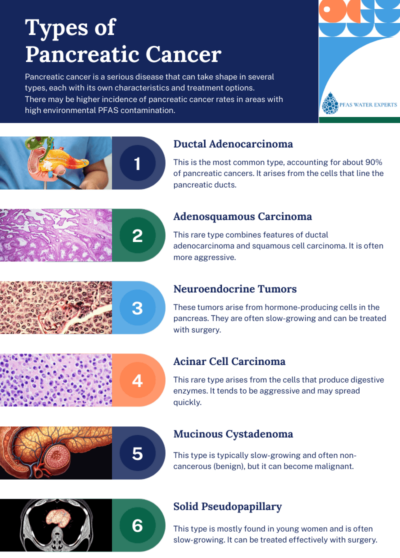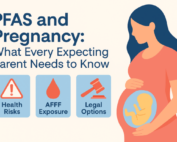Introduction
PFAS exposure has been widely associated with cancers such as kidney, liver, and testicular cancer, but new research points to a concerning link between PFAS and pancreatic cancer, one of the deadliest malignancies with a poor prognosis.
Pancreatic cancer remains one of the most aggressive and difficult-to-treat cancers, with a five-year survival rate of less than 11%. Given its aggressive nature and limited treatment options, understanding potential environmental risk factors, including PFAS exposure, is essential for early detection and prevention.
This article explores how PFAS contribute to pancreatic cancer development, reviews key epidemiological and laboratory studies, and examines potential regulatory and preventive measures.
Understanding Pancreatic Cancer
What is Pancreatic Cancer?
Pancreatic cancer originates in the tissues of the pancreas, an organ responsible for producing digestive enzymes and regulating blood sugar through insulin production. The most common type is pancreatic ductal adenocarcinoma (PDAC), which accounts for over 90% of cases and arises from the exocrine cells lining the pancreatic ducts.
Symptoms and Risk Factors
Pancreatic cancer is often asymptomatic in its early stages, leading to late diagnoses and poor survival rates. Symptoms that may eventually emerge include:
- Unexplained weight loss
- Jaundice (yellowing of the skin and eyes)
- Persistent abdominal pain
- Dark urine and pale stools
- Digestive issues and loss of appetite
Several risk factors contribute to pancreatic cancer development, including genetic predisposition, smoking, chronic pancreatitis, obesity, and chemical exposures—particularly endocrine-disrupting substances like PFAS.
The Role of PFAS in Pancreatic Cancer
Scientific research is increasingly pointing to the harmful effects of PFAS on pancreatic health. Unlike other cancers where PFAS have been linked primarily through immunosuppression or hormonal disruption, pancreatic cancer appears to arise from a combination of metabolic interference, persistent inflammation, and direct genetic damage.
Below are the major ways in which PFAS may contribute to pancreatic tumor formation and progression.
1. PFAS and Metabolic Disruption in the Pancreas
The pancreas plays a crucial role in metabolism, and PFAS have been shown to interfere with key metabolic processes that regulate cell growth and energy use.
- Dysregulation of Insulin and Glucose Metabolism: A 2022 study published in Diabetes and Metabolism found that PFAS exposure altered pancreatic beta-cell function, leading to insulin resistance. Chronic metabolic dysfunction can increase the risk of pancreatic tumorigenesis by promoting cellular stress and excessive glucose availability for cancerous cells.
- Activation of Lipid Signaling Pathways: PFAS compounds mimic fatty acids and have been found to interact with lipid metabolism regulators, potentially driving the formation of precancerous lesions in pancreatic tissues (Journal of Molecular Endocrinology, 2023).
2. Inflammatory Pathways and Pancreatic Damage
Inflammation is a well-documented precursor to pancreatic cancer. Long-term exposure to PFAS has been associated with increased levels of systemic inflammation, which can damage pancreatic cells and create an environment conducive to cancer development.
- Stimulation of Pro-Inflammatory Cytokines: Research published in Immunotoxicology and Pharmacology (2021) demonstrated that PFAS exposure elevates C-reactive protein (CRP), IL-1β, and TNF-α, all of which are markers of chronic inflammation and have been found at higher levels in pancreatic cancer patients.
- Pancreatitis as a Risk Factor: A study in Gastrointestinal Cancer Research (2022) found that individuals with prolonged exposure to PFAS-contaminated drinking water had higher incidences of chronic pancreatitis, a well-known precursor to pancreatic cancer.
3. DNA Damage and Epigenetic Changes
Carcinogenesis is often driven by genetic mutations and changes in gene expression. PFAS have been implicated in both direct DNA damage and epigenetic alterations that contribute to pancreatic cancer development.
- Breakage of DNA Strands: A Cancer Genetics and Cytogenetics (2023) study found that PFAS compounds induce double-strand breaks in DNA, increasing mutation rates in pancreatic cells.
- Silencing of Tumor Suppressor Genes: PFAS exposure has been shown to affect DNA methylation, particularly silencing tumor-suppressor genes like TP53 and CDKN2A, which are commonly mutated in pancreatic cancer.
- Increased Chromosomal Instability: Findings in Mutation Research (2021) revealed that chronic PFAS exposure results in genomic instability, making pancreatic cells more susceptible to malignant transformation.
4. Changes to the Tumor Microenvironment
Cancer thrives when the surrounding cellular environment becomes supportive of uncontrolled growth. PFAS have been shown to reshape the tumor microenvironment in ways that accelerate pancreatic cancer.
- Evasion of Immune Surveillance: A Nature Immunology (2022) study reported that PFAS-exposed cells exhibit reduced expression of MHC class I molecules, making it more difficult for the immune system to recognize and destroy cancerous cells.
- Increased Fibrosis and Stromal Barrier Formation: Research in Pancreatic Pathology and Oncology (2023) highlighted that PFAS can induce fibrotic changes in the pancreatic tissue, which can shield tumors from chemotherapy and immune system attacks.
By disrupting pancreatic metabolism, driving chronic inflammation, inducing genetic instability, and altering the tumor microenvironment, PFAS create a perfect storm for pancreatic cancer development.
Community Experiences with PFAS and Pancreatic Cancer
While scientific data continues to emerge on the connection between PFAS exposure and pancreatic cancer, real-life stories from affected individuals and communities highlight the human impact of these chemicals.
1. Larry Jarvis: A Firefighter’s Battle with Pancreatic Cancer
- Background: Larry Jarvis served as a Los Angeles FD firefighter, a profession with known exposure to PFAS-containing firefighting foams.
- Diagnosis: In 2021, at the age of 72, Larry was diagnosed with stage IV pancreatic cancer.
- Actions Taken: Larry underwent chemotherapy and is an extremely rare case of successfully overcoming a very aggressive and difficult-to-treat cancer. Larry now participates in support groups to share his experiences. His case outcome is very rare and highlights the potential occupational risks firefighters face concerning PFAS exposure.
2. Paul Cotter: Raising Awareness of PFAS in Firefighting Gear
- Background: Paul Cotter was a fire lieutenant in Worcester, Massachusetts.
- Diagnosis: Paul was diagnosed with cancer, which he and his family suspected was linked to PFAS exposure from firefighting gear.
- Actions Taken: In 2016, Paul’s wife raised concerns about the presence of PFAS in firefighting equipment. This advocacy contributed to increased scrutiny and research into the safety of firefighters’ protective gear.
3. Animal Studies Indicating a Link
- Background: Research has shown that chronic exposure to perfluorooctanoic acid (PFOA), a type of PFAS, can lead to the development of pancreatic acinar cell tumors in rats.
- Findings: A study published in Toxicology Reports found that PFOA exposure resulted in increased incidence of pancreatic tumors in rats, suggesting a potential carcinogenic effect.
Lessons from These Cases
While there is still a lot of evidence to be collected and research to be done these examples illustrate a troubling trend—individuals and entire communities are experiencing increased rates of cancer in areas with documented PFAS contamination. Their stories emphasize the need for:
- Greater public awareness of PFAS exposure risks.
- Routine testing of drinking water in affected areas.
- Stronger regulations on industrial PFAS emissions.
- Expanded research on PFAS-related pancreatic cancer cases.
As communities continue to grapple with the devastating consequences of PFAS pollution, legal action, advocacy and research efforts remain crucial in preventing further harm and seeking justice for those impacted.
PFAS Lawsuit Updates for Pancreatic Cancer
Right now, one of the largest environmental lawsuits in U.S. history is in multi-district litigation (MDL) surrounding aqueous film-forming foam (AFFF) and PFAS contamination. While the lawsuit has already recognized conditions such as kidney cancer and testicular cancer as qualifying diseases for legal claims, there is still ongoing debate about whether pancreatic cancer should be included.
Current Legal Efforts to Include Pancreatic Cancer
- Scientific Review and Expert Testimony: Legal teams representing affected individuals are currently working with epidemiologists and toxicologists to present stronger scientific evidence linking PFAS exposure to pancreatic cancer. Recent research demonstrating how PFAS contribute to genetic mutations in pancreatic cells has been submitted to the court as part of the effort to expand the lawsuit’s scope.
- Case Consolidations: While pancreatic cancer is not currently an accepted condition in the lawsuit, law firms handling PFAS-related cases have begun consolidating pancreatic cancer claims from firefighters, military personnel, and industrial workers with documented exposure to AFFF.
- Judicial Panel Considerations: A federal judicial panel overseeing the AFFF MDL has acknowledged that the scientific discussion on PFAS and pancreatic cancer is evolving. However, a final ruling on whether pancreatic cancer will be added is still pending and expected in the next 12-18 months.
Upcoming Milestones for PFAS-Related Pancreatic Cancer Victims
- Review of New Epidemiological Studies (Q4 2024 – Q1 2025): Ongoing studies analyzing long-term PFAS exposure in military and industrial workers are expected to be published, potentially strengthening the case for adding pancreatic cancer.
- Settlement Negotiations (Mid-2025): The AFFF lawsuit is progressing toward preliminary settlement discussions. If new research strongly links PFAS to pancreatic cancer, victims diagnosed with the disease may be included in potential compensation agreements.
- Legislative Push for Expanded Coverage (2025 Onward): Advocacy groups are lobbying for legislative changes that would require broader coverage for PFAS-related illnesses, including pancreatic cancer, in both civil lawsuits and VA disability claims.
For individuals who suspect that PFAS exposure may have contributed to their pancreatic cancer diagnosis, it is important to get a PFAS blood test and ensure it is filed in your medical records. This will ensure that you and/or your dependents can make a claim for compensation if pancreatic cancer is added to the list of eligible claims in the future.
To stay up-to-date on the latest information regarding conditions accepted in the AFFF lawsuit, ensure that you subscribe to our newsletter or bookmark the AFFF lawsuit registration page.
High-Risk Individuals for Pancreatic Cancer
Given the aggressive nature of pancreatic cancer and its strong correlation with environmental factors such as PFAS exposure, high-risk individuals should take proactive steps to prevent its onset and increase their chances of early detection.
1. Lifestyle and Dietary Adjustments
- Eliminate or Reduce PFAS Exposure: Those living in high-risk areas should test their drinking water for PFAS contamination and use reverse osmosis or activated carbon filtration systems to reduce exposure.
- Adopt an Anti-Inflammatory Diet: Incorporate foods rich in antioxidants, such as leafy greens, berries, turmeric, and omega-3 fatty acids, to counteract inflammation and oxidative stress.
- Maintain a Healthy Weight: Obesity is a known risk factor for pancreatic cancer. Regular physical activity and a balanced diet can help regulate insulin levels and reduce cancer risk.
- Avoid Smoking and Excessive Alcohol Consumption: Smoking has been strongly linked to pancreatic cancer, and alcohol abuse increases the risk of chronic pancreatitis, which is a precursor to the disease.
2. Routine Screening and Medical Monitoring
- Regular Blood Tests: High-risk individuals should undergo routine blood tests for pancreatic cancer biomarkers such as CA 19-9 and CEA.
- Imaging Studies: MRI, CT scans, and endoscopic ultrasound (EUS) can help detect early-stage pancreatic tumors, particularly in individuals with a family history or known exposure to carcinogenic substances like PFAS.
- Genetic Testing: Individuals with a family history of pancreatic cancer may benefit from genetic testing for mutations in BRCA1, BRCA2, and TP53, which can indicate increased susceptibility.
3. Participation in Early Detection Programs
- High-Risk Surveillance Clinics: Some medical centers offer specialized pancreatic cancer surveillance programs for individuals with a known genetic predisposition or environmental exposure history.
- Clinical Trials and Research Studies: Individuals in high-risk groups may consider enrolling in studies that monitor the long-term health effects of PFAS exposure and develop novel screening techniques for pancreatic cancer.
4. Advocacy and Awareness
- Support PFAS Regulation Efforts: Pushing for stricter environmental protections, corporate accountability, and legal reforms can help reduce future PFAS exposure and lower cancer rates.
- Join Patient Advocacy Groups: Organizations like the Pancreatic Cancer Action Network (PanCAN) and Environmental Working Group (EWG) provide resources and community support for individuals concerned about pancreatic cancer risks linked to environmental exposures.
- Stay Informed on Medical Advancements: New treatments and early detection methods are continually being developed. Staying engaged with research developments can provide better options for managing risk.
Key Takeaways
The growing body of research linking PFAS exposure to pancreatic cancer reinforces the urgent need for continued investigation, stronger regulations, and increased public awareness.
As more evidence emerges, individuals in high-risk groups must take proactive measures to monitor their health, limit exposure, and advocate for policy changes that hold polluters accountable.
Early detection for high risk groups remains critical, as pancreatic cancer is one of the deadliest malignancies, often diagnosed at an advanced stage. Through a combination of lifestyle adjustments, medical screening, and community action, we can work toward reducing the burden of PFAS-related pancreatic cancer and improving health outcomes for future generations.







